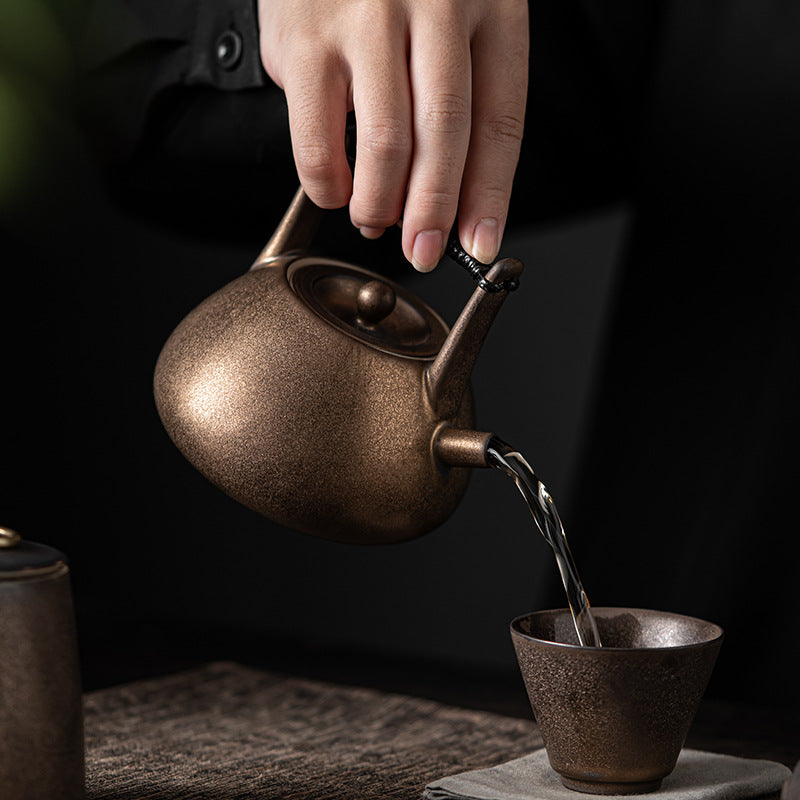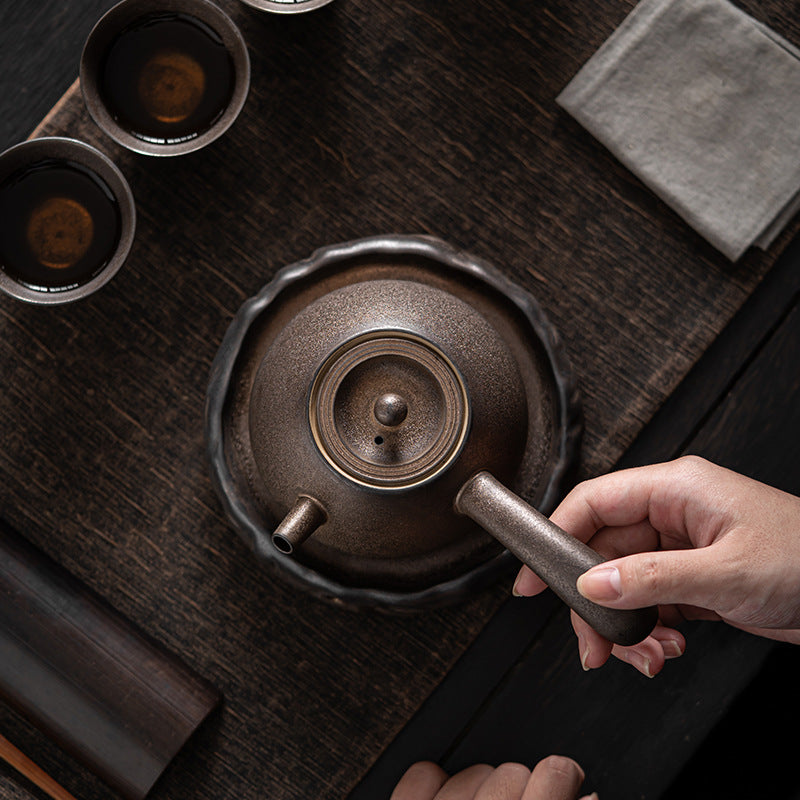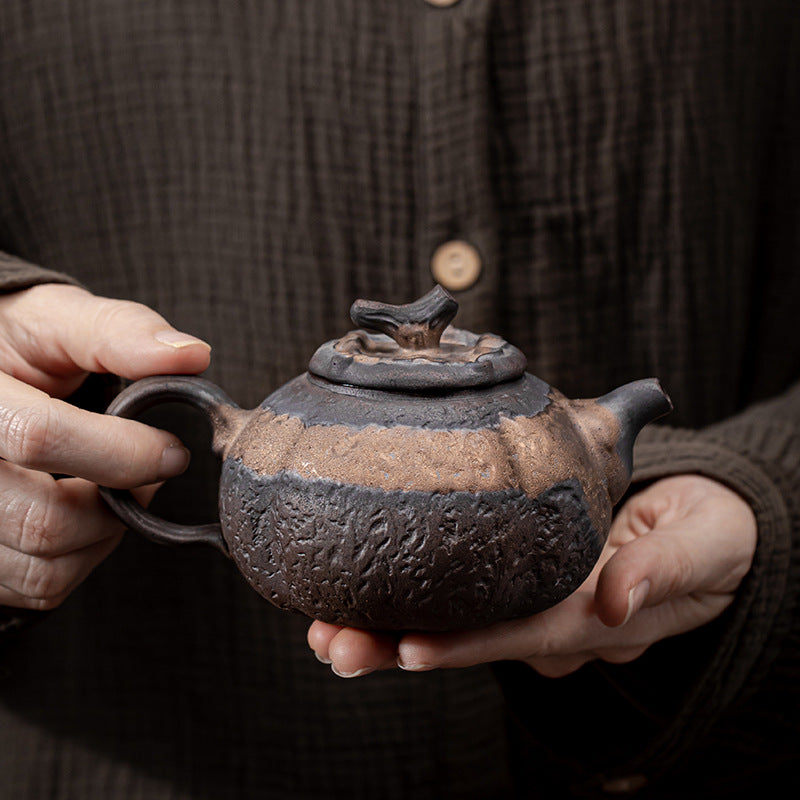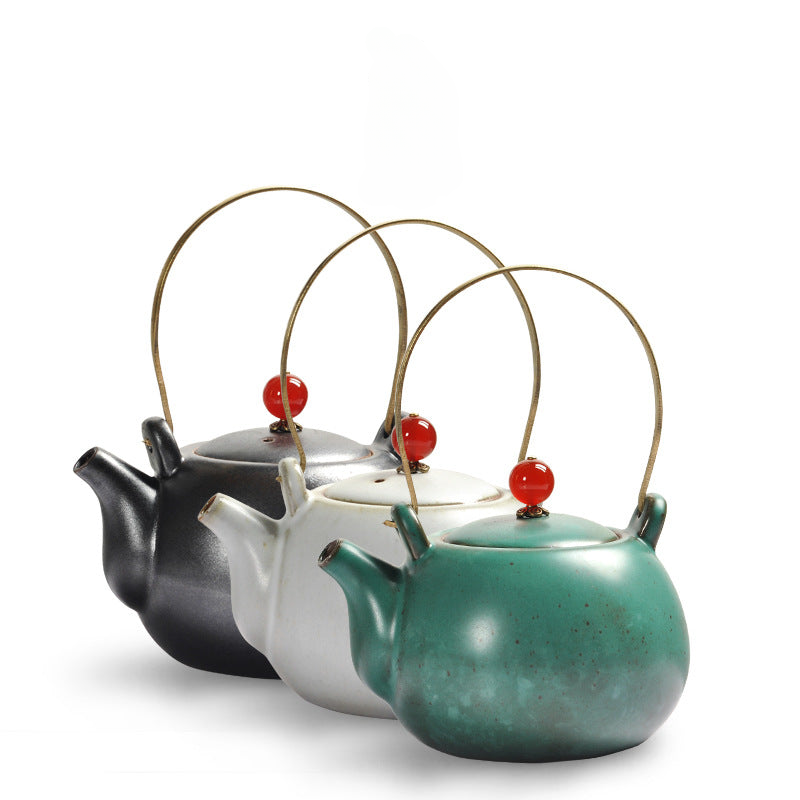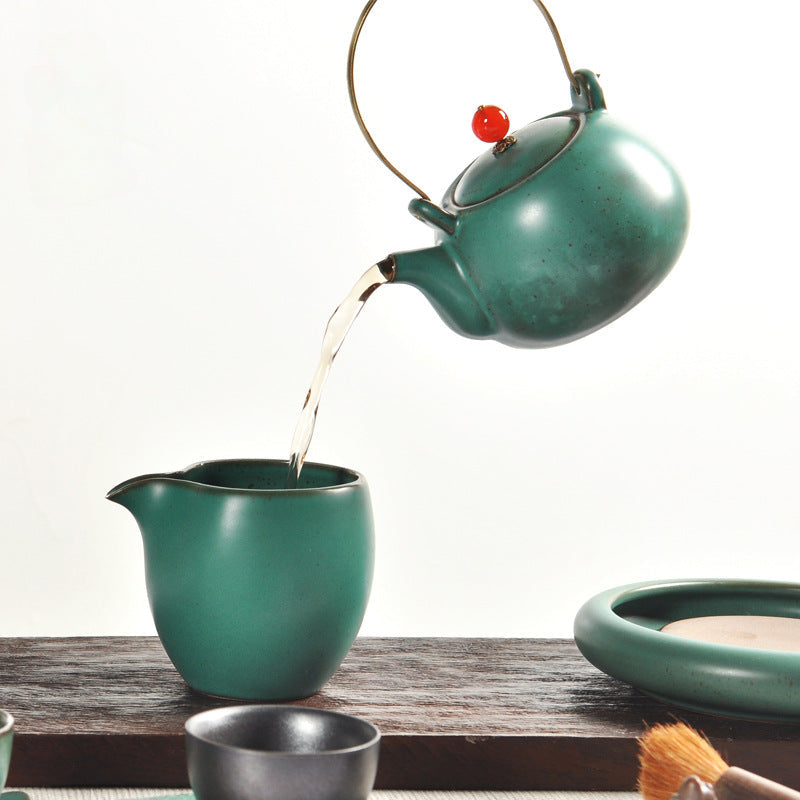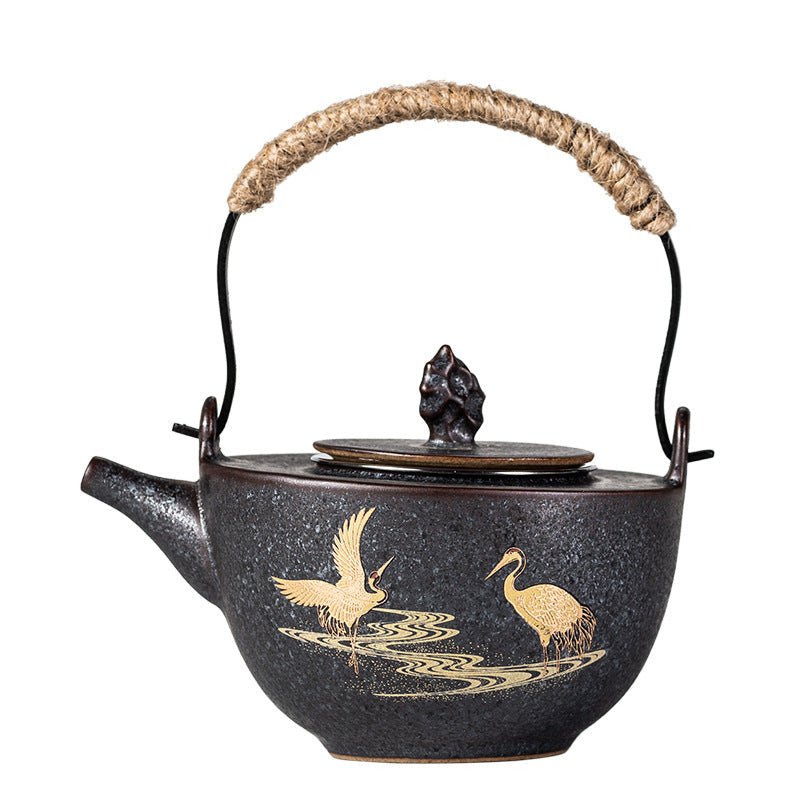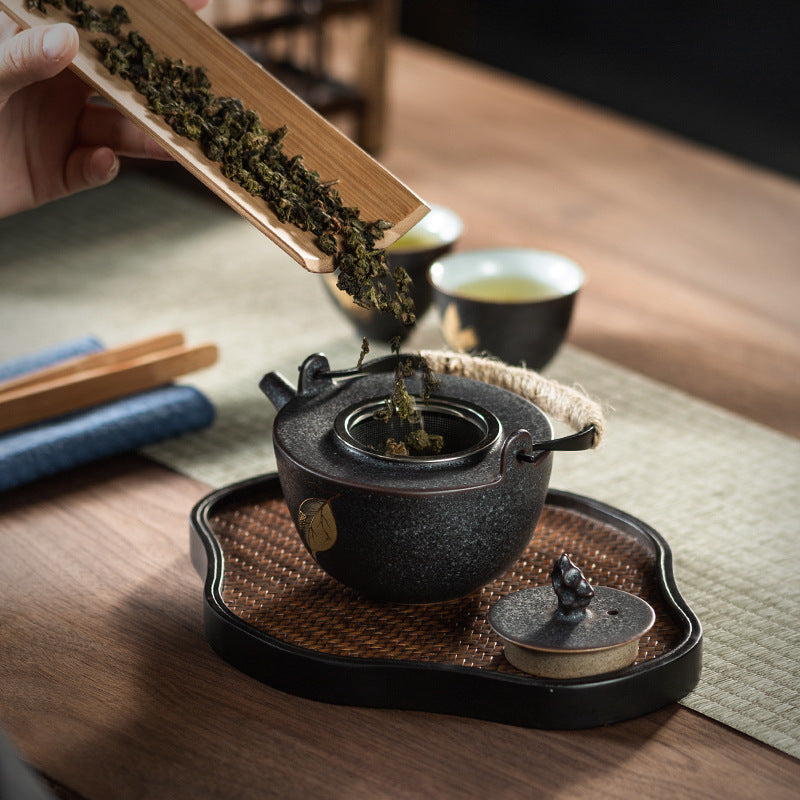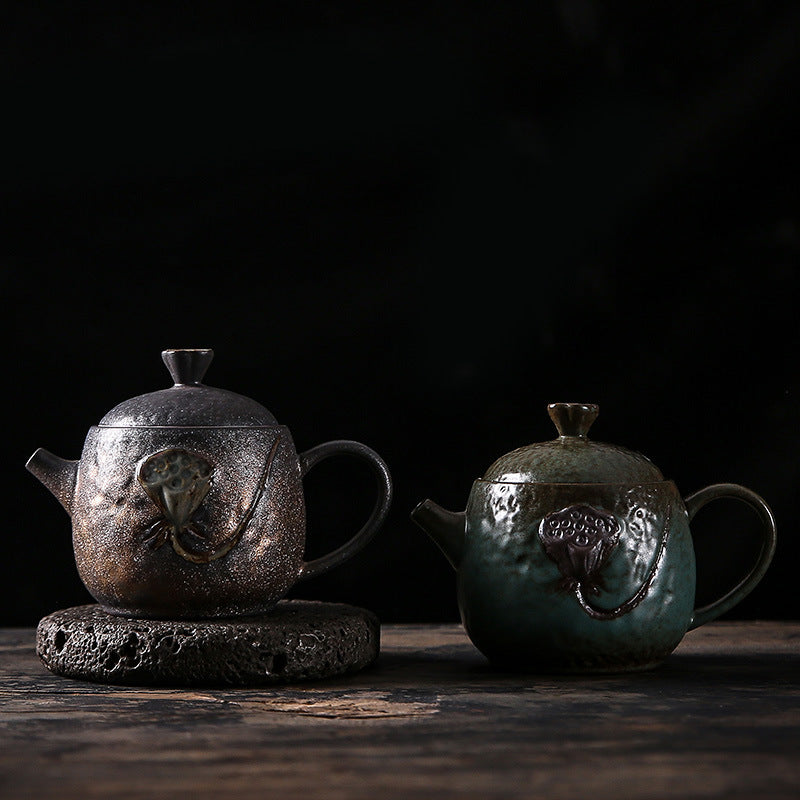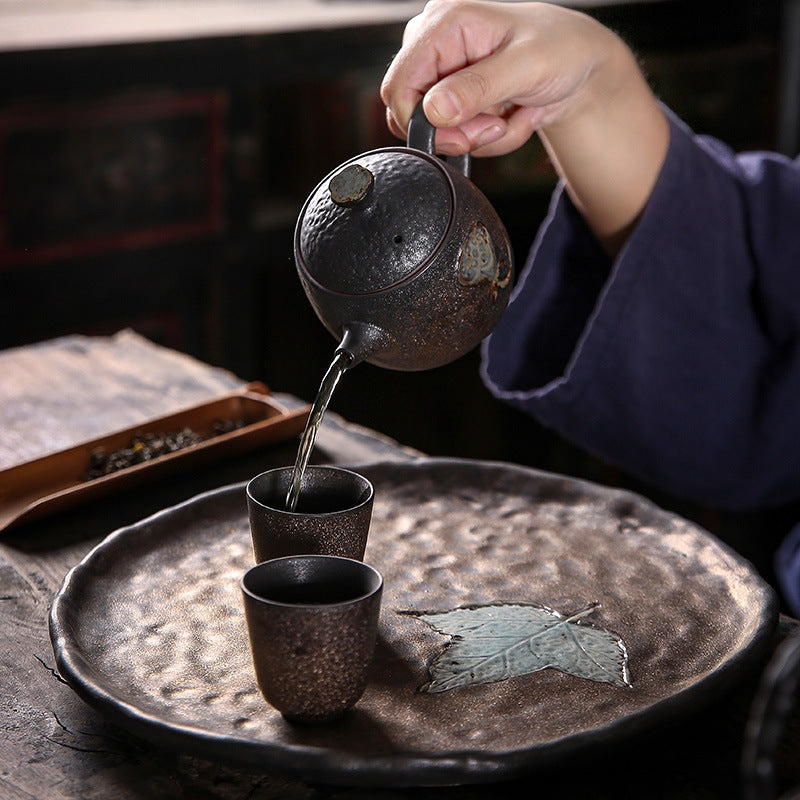-
Chinese Handmade Enameled Cast Iron Small TeapotChinese Handmade Enameled Cast Iron Small Teapot
- Regular price
-
$156.00 USD - Regular price
-
$0.00 USD - Sale price
-
$156.00 USD
Quick view
-
Japanese Style Gilding Iron Glaze Side Handle TeapotJapanese Style Gilding Iron Glaze Side Handle Teapot
- Regular price
-
$69.00 USD - Regular price
-
$0.00 USD - Sale price
-
$69.00 USD
Quick view
-
Qingxi Purple Pottery Cool Side Handle TeapotQingxi Purple Pottery Cool Side Handle Teapot
- Regular price
-
$134.00 USD - Regular price
-
$0.00 USD - Sale price
-
$134.00 USD
Quick view
-
Japanese Style Gilding Iron Glaze Persimmon TeapotJapanese Style Gilding Iron Glaze Persimmon Teapot
- Regular price
-
$89.00 USD $99.00 USD - Regular price
-
$0.00 USD - Sale price
-
$89.00 USD $99.00 USD
Quick view
-
Japanese-Style Handmade Ceramic Ice Gray Glaze Small TeapotJapanese-Style Handmade Ceramic Ice Gray Glaze Small Teapot
- Regular price
-
$65.00 USD - Regular price
-
$0.00 USD - Sale price
-
$65.00 USD
Quick view
-
Japanese Style Handmade Retro Gilding TeapotJapanese Style Handmade Retro Gilding Teapot
- Regular price
-
$59.00 USD - Regular price
-
$0.00 USD - Sale price
-
$59.00 USD
Quick view
-
Gracked Glaze Ru Ware TeapotGracked Glaze Ru Ware Teapot
- Regular price
-
$97.00 USD - Regular price
-
$0.00 USD - Sale price
-
$97.00 USD
Quick view
-
Handmade Pinching Flower Light Luxury Small TeapotHandmade Pinching Flower Light Luxury Small Teapot
- Regular price
-
$112.00 USD $285.00 USD - Regular price
-
$0.00 USD - Sale price
-
$112.00 USD $285.00 USD
Quick view
-
Japanese Style Porcelain Creative Kiln Baked RetroTeapotJapanese Style Porcelain Creative Kiln Baked RetroTeapot
- Regular price
-
$79.00 USD $89.00 USD - Regular price
-
$0.00 USD - Sale price
-
$79.00 USD $89.00 USD
Quick view
-
Japanese Style Coarse Pottery TeaPotJapanese Style Coarse Pottery TeaPot
- Regular price
-
$69.00 USD - Regular price
-
$0.00 USD - Sale price
-
$69.00 USD
Quick view
-
Japanese Style Handmade Stoneware TeapotJapanese Style Handmade Stoneware Teapot
- Regular price
-
$64.00 USD - Regular price
-
$0.00 USD - Sale price
-
$64.00 USD
Quick view
-
Japanese Style Handmade Retro Kiln Baked Ceramic TeapotJapanese Style Handmade Retro Kiln Baked Ceramic Teapot
- Regular price
-
$80.00 USD - Regular price
-
$0.00 USD - Sale price
-
$80.00 USD
Quick view
-
Handmade Ru Porcelain Ceramic TeapotHandmade Ru Porcelain Ceramic Teapot
- Regular price
-
$179.00 USD - Regular price
-
$0.00 USD - Sale price
-
$179.00 USD
Quick view
-
Japanese Style Handmade Stoneware Little TeapotJapanese Style Handmade Stoneware Little Teapot
- Regular price
-
$56.00 USD - Regular price
-
$0.00 USD - Sale price
-
$56.00 USD
Quick view
-
Retro Kiln Baked Green Glaze TeapotRetro Kiln Baked Green Glaze Teapot
- Regular price
-
$79.00 USD - Regular price
-
$0.00 USD - Sale price
-
$79.00 USD
Quick view
-
Handmade Water Cut-off Neat Small TeapotHandmade Water Cut-off Neat Small Teapot
- Regular price
-
$143.00 USD - Regular price
-
$0.00 USD - Sale price
-
$143.00 USD
Quick view
-
Purple Pottery Long Leisure Pot Handmade TeapotPurple Pottery Long Leisure Pot Handmade Teapot
- Regular price
-
$125.00 USD - Regular price
-
$0.00 USD - Sale price
-
$125.00 USD
Quick view
-
Handmade Jump Knife Pattern Glazed Polished Ceramic TeapotHandmade Jump Knife Pattern Glazed Polished Ceramic Teapot
- Regular price
-
$125.00 USD - Regular price
-
$0.00 USD - Sale price
-
$125.00 USD
Quick view
-
Hand Painted Smoothly Ceramic Teapot Single TeapotHand Painted Smoothly Ceramic Teapot Single Teapot
- Regular price
-
$89.99 USD - Regular price
-
$0.00 USD - Sale price
-
$89.99 USD
Quick view
-
Japanese Style Gilding Iron Glaze TeapotJapanese Style Gilding Iron Glaze Teapot
- Regular price
-
$75.00 USD - Regular price
-
$0.00 USD - Sale price
-
$75.00 USD
Quick view
-
Silver Spot Beam Pot Japanese Retro Stoneware TeapotSilver Spot Beam Pot Japanese Retro Stoneware Teapot
- Regular price
-
$65.00 USD - Regular price
-
$0.00 USD - Sale price
-
$65.00 USD
Quick view
-
Lotus Seedpod Gilding Iron Glaze Stoneware TeapotLotus Seedpod Gilding Iron Glaze Stoneware Teapot
- Regular price
-
$75.00 USD - Regular price
-
$0.00 USD - Sale price
-
$75.00 USD
Quick view
-
Lang Hongfu Gas Pot Porcelain Small Hand-Held Single TeapotLang Hongfu Gas Pot Porcelain Small Hand-Held Single Teapot
- Regular price
-
$293.00 USD - Regular price
-
$0.00 USD - Sale price
-
$293.00 USD
Quick view
-
Japanese Style Handmade Kiln Baked Qingye TeapotJapanese Style Handmade Kiln Baked Qingye Teapot
- Regular price
-
$61.00 USD - Regular price
-
$0.00 USD - Sale price
-
$61.00 USD
Quick view
-
Vintage Ceramic Persimmon TeawaresetVintage Ceramic Persimmon Teawareset
- Regular price
-
$236.00 USD $275.00 USD - Regular price
-
$0.00 USD - Sale price
-
$236.00 USD $275.00 USD
Quick view
-
Japanese Style Simple Home Stoneware TeapotJapanese Style Simple Home Stoneware Teapot
- Regular price
-
$129.00 USD $279.00 USD - Regular price
-
$0.00 USD - Sale price
-
$129.00 USD $279.00 USD
Quick view
-
Smoky Gray Glaz Yunhuai Side Handle TeapotSmoky Gray Glaz Yunhuai Side Handle Teapot
- Regular price
-
$54.00 USD - Regular price
-
$0.00 USD - Sale price
-
$54.00 USD
Quick view
-
Mountain and Sea View Gradient Loop-Handled TeapotMountain and Sea View Gradient Loop-Handled Teapot
- Regular price
-
$72.00 USD - Regular price
-
$0.00 USD - Sale price
-
$72.00 USD
Quick view
-
Black Porcelain Gold Drawing TeapotBlack Porcelain Gold Drawing Teapot
- Regular price
-
$172.00 USD - Regular price
-
$0.00 USD - Sale price
-
$172.00 USD
Quick view
-
Ice Flower Glaze Lotus Seedpod TeapotIce Flower Glaze Lotus Seedpod Teapot
- Regular price
-
$85.00 USD $125.00 USD - Regular price
-
$0.00 USD - Sale price
-
$85.00 USD $125.00 USD
Quick view
-
Japanese Style Coarse Pottery Kiln Baked TeapotJapanese Style Coarse Pottery Kiln Baked Teapot
- Regular price
-
$151.00 USD - Regular price
-
$0.00 USD - Sale price
-
$151.00 USD
Quick view
-
Persimmon Glaze Powder Pointing Gold Hanwa Handmade TeapotPersimmon Glaze Powder Pointing Gold Hanwa Handmade Teapot
- Regular price
-
$95.00 USD - Regular price
-
$0.00 USD - Sale price
-
$95.00 USD
Quick view
-
Kingyuan Color Handmade Hanwa TeapotKingyuan Color Handmade Hanwa Teapot
- Regular price
-
$99.50 USD - Regular price
-
$0.00 USD - Sale price
-
$99.50 USD
Quick view
-
Handmade Japanese Style 9-Head Kung Fu Tea SetHandmade Japanese Style 9-Head Kung Fu Tea Set
- Regular price
-
$185.00 USD - Regular price
-
$0.00 USD - Sale price
-
$185.00 USD
Quick view
-
Qingxi Purple Pottery Bamboo TeapotQingxi Purple Pottery Bamboo Teapot
- Regular price
-
$134.00 USD - Regular price
-
$0.00 USD - Sale price
-
$134.00 USD
Quick view
-
Japanese-Style Office Household Tea SetJapanese-Style Office Household Tea Set
- Regular price
-
$275.00 USD $295.00 USD - Regular price
-
$0.00 USD - Sale price
-
$275.00 USD $295.00 USD
Quick view
-
Dehua Sheep Fat Jade Porcelain Tea SetDehua Sheep Fat Jade Porcelain Tea Set
- Regular price
-
$75.00 USD - Regular price
-
$0.00 USD - Sale price
-
$75.00 USD
Quick view
-
Chinese Style Handmade Coarse Pottery Small Ruihe TeapotChinese Style Handmade Coarse Pottery Small Ruihe Teapot
- Regular price
-
$89.99 USD $99.99 USD - Regular price
-
$0.00 USD - Sale price
-
$89.99 USD $99.99 USD
Quick view
-
White Jade Vegetarian Burning White Porcelain TeapotWhite Jade Vegetarian Burning White Porcelain Teapot
- Regular price
-
$125.00 USD - Regular price
-
$0.00 USD - Sale price
-
$125.00 USD
Quick view
-
Jiji Style Stoneware Side Handle TeapotJiji Style Stoneware Side Handle Teapot
- Regular price
-
$70.00 USD - Regular price
-
$0.00 USD - Sale price
-
$70.00 USD
Quick view
What is a teapot?
A teapot is a specialized vessel for steeping tea leaves, typically equipped with a lid, spout, and handle. On the other hand, a kettle is primarily used to heat water and pour it into different containers. The primary distinctions between the two lie in their design and purpose. Teapots often feature tea strainers or built-in filters, which separate tea leaves from the water, a feature not typically found in kettles. Furthermore, teapots emphasize aesthetics and tea culture.
How does it differ from a kettle?
|
Difference |
Teapot |
Kettle |
|
Use |
Specifically for brewing and drinking tea |
Used for cooking, boiling watering, etc. multi-purposes |
|
Material |
Ceramic, porcelain and other heat-retaining materials |
No restrictions, mostly stainless steel or plastic |
|
Structure |
Usually has a strainer to separate tea leaves from water |
Generally no strainer structure |
|
Size |
Small and exquisite, capacity usually 0.3-0.5L |
Convenient and large capacity for watering, 1-3L or larger |
What qualities contribute to an optimal teapot usage experience?
The optimal teapot usage experience hinges upon several factors:
- Materials: Different materials influence the taste of the tea differently. For instance, Yixing clay teapots are considered as the gold standard due to their ability to absorb tea aromas and gradually release them over multiple uses.
- Size: The teapot size should be determined by the number of individuals you usually serve tea to and the type of tea you prefer. Green tea, for instance, often requires a larger teapot to allow the leaves to expand fully. Small teapots around 0.3-0.5L capacity, are suitable for personal drinking.
- Design: A well-designed teapot should facilitate easy operations, such as effortless water pouring and convenient cleaning.
Is a teapot exclusively for brewing tea?
Although a teapot is predominantly used for steeping tea, it can also serve other purposes. For example, it can function as a decorative item, enhancing the aesthetic appeal of your living space. Furthermore, certain teapots can be utilized for steeping other hot beverages like herbal teas or coffee. However, this might necessitate alterations to the teapot's internal structure, potentially affecting its tea brewing efficacy.
What should one consider when purchasing a teapot?
When shopping for a teapot, several factors warrant consideration:
- Usage: What kind of tea do you primarily intend to brew? Different types of tea may call for distinct teapot designs.
- Materials: What material do you desire for your teapot? Various materials offer different insulation properties and influence tea flavor differently.
- Size: How large of a teapot do you require? A compact teapot may suffice for individual or small-group use, while larger gatherings might necessitate a bigger one.
- Price: What is your budget? Teapot prices can range from tens to thousands of dollars, contingent on factors like material, craftsmanship, and brand.
- Design: What design will attract you? Teapot designs span from utilitarian simplicity to intricate sophistication, each offering a unique usage experience.
Metal teapot vs. ceramic teapot
|
Criteria |
Metal Teapot |
Ceramic Teapot |
|
Heat Retention |
Poor. Metal conducts heat quickly. Tea can become bitter and oversteeped. |
Good. Ceramics is an insulator and retains heat well to steep tea properly. |
|
Durability |
Durable. Resists chips and cracks. |
More delicate.Easily broken. |
|
Flavor |
It can impart a metallic taste. Not ideal for delicate teas. |
Inert. Does not affect tea flavor. |
|
Styles |
Limited styles. Mostly stainless steel. |
Many styles and designs like porcelain, stoneware, etc. |
|
Weight |
Lightweight. Easy to lift and pour. |
Heavier, especially when full. |
|
Price |
Affordable. Lower cost. |
Various. Fine ceramic teapots can be expensive. |
|
Ease of Use |
Easy to clean. Won't absorb odors or stains. |
Requires more care. Ceramics is porous. |
|
Suitability |
Best for inexpensive, everyday teas. |
Better for high quality loose leaf teas. Enhances flavor. |
In summary:
- Metal teapots are durable and lightweight but don't retain heat well. Ceramic teapots are better insulated for steeping but are more delicate.
- Ceramic teapots allow you to appreciate the subtle flavors of fine teas. Metal can impart a metallic taste.
- Ceramics offers more variety in styles and designs. Metal teapots are usually basic stainless steel.
- Ceramic requires more care, while metal is easier to clean.
- Ceramic teapots are better suited for brewing high-quality loose leaf tea.
On this page, you'll encounter a multitude of meticulously crafted teapots, boasting diversity in design, materials, and craftsmanship. Each teapot possesses its distinct charm and attributes, enabling you to select the one that aligns best with your preferences and requirements.




